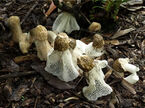
In The Rainforest this week
Thu 25 Feb
In The Rainforest this week
By Hans Van Veluwen
In our Rainforests and flowering now is a must have tree for every tropical garden where space permits, it's the evergreen bisexual Ylang Ylang Tree (Cananga odorata). Also known as the Macassar Oil Plant. This tree is closely related to the custard apple tree and is fairly fast growing.
A semi hardwood tree that grows to about ten meters tall and is best planted away from structures as it is also known to be brittle and it's branches can snap during heavy wind gusts. It's another one of our rainforest treasures that blooms best in our Gondwana Green season.
Native to South East Asia, New Guinea, Pacific Island regions as well as Tropical Australia this tall evergreen produces profusions of insignificant looking yellow drooping flowers from its branches. These flowers are intoxicatingly fragrant with an intensely sweet rich floral scent.
The the volatile essential oils extracted from the flowers is the main ingredient to many perfumes, including Chanel #5. Also well known in aromatherapy as an essential oil that generally gives one a feeling of intense well being, used to calm anxiety and nervousness, reduce stress and nervous tension, as well as irritability. It seduces the senses and relaxes the mind. Its exotic, spicy aroma has been said to be an aphrodisiac ; the perfect tonic for the bedroom.
Another intensely smelly or pungent growth seen at this time of the year is the Stink Horn Fungi. Erupting from nearly every freshly laid bed of compost in gardens and forests throughout North Queensland at the moment, these fungi come in many different shapes but have similar characteristics in that they all produce a sticky liquid spore usually on top of a head perched on a very phallic looking stalk. Some have delicate veils that look like lace surrounding the stalks from the spore head to the ground.
Short lived and very delicate they produce a pungent smell that is similar to the scent of rotting meat or faeces to attract flies and other insects to distribute their sticky spore. Usually found in beds of organic rich composts and when the humidity levels are very high. Fungi help to recycle fallen timber and organic debris. If it were not for the important role played by fungi, the diversity of understorey plants species would be greatly reduced. Fungi also return nitrogen from the air into the soil so that other plants are able to benefit. Keep your eyes on the ground if you want to see some of the diverse types of fungi especially at this time of the year.
The photo I have included is of the Maiden Veil Fungus (Phallus indusiata). In some parts of Asia it is consumed as a food, apparently, Stinkhorn is available dried in well stocked Oriental grocery stores. They look very unpromising as nearly weightless papery shreds but they rehydrate into a mesh stem with an ethereal floating veil. Rehydrate them by soaking in lightly salted water for 20 minutes, then in boiling water for 1 minute.
They have just a little earthy flavor of their own but a delicate crunchy texture that holds up well to cooking and a mesh structure that holds light sauces and broth flavors extremely well. Use them in soups, stews and other light liquidy dishes where they add substance and texture. Nutritionally they are high in fiber and amino acids. The photos for this weeks subjects were taken in one of the most incredible tropical Gardens I have ever seen in North Queensland, thank you to Judy Terracall.
About Hans Van Veluwen
Hans Van Veluwen is a Wilderness Guide who has been conducting trekking expeditions and Guided Tours/ Safaris in Far North Queensland for 31 years. A horticulturist who found out 30 years ago that it was a lot easier talking about plants for a living than physically growing them. He is Queensland's leading Stereophotographer, who has published 3D books about this wonderful part of the world.
Nowadays freelancing for various reputable tour companies as well as offering private guiding services to those people that want to know all about the ecology and history of the area, presented in a way people can understand and appreciate. He specialises in Rainforest Ecology Interpretation tours and also conducts photography tours for those people that want more than a normal scheduled trip. For more details visit www.C3D.net.au

